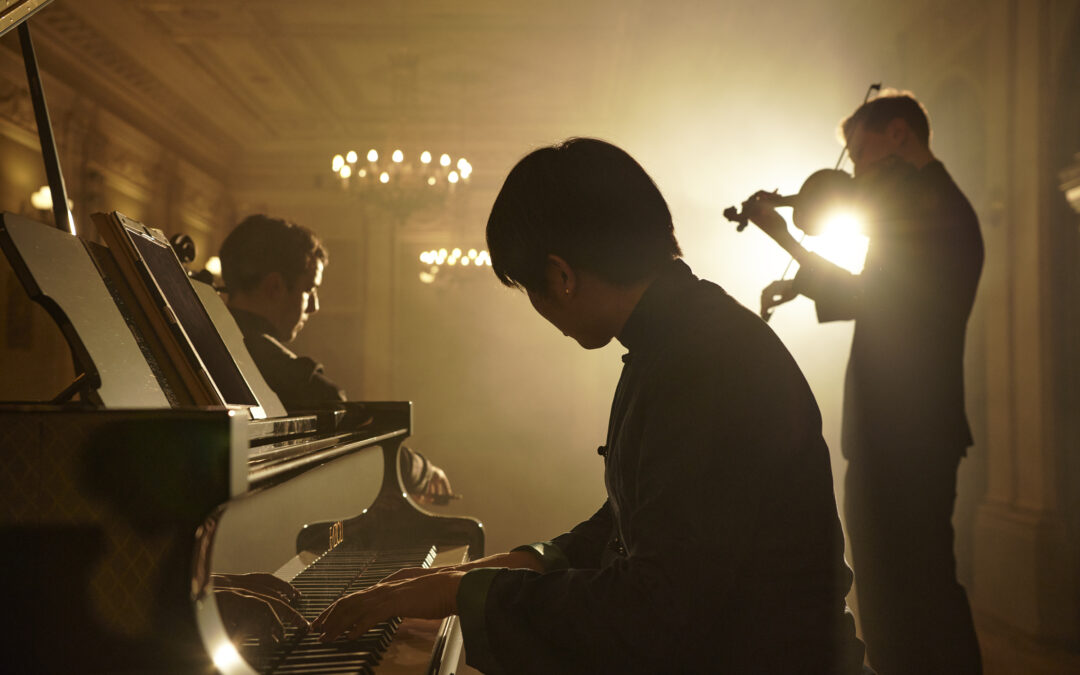By Montague Gammon III
The fast rising, internationally acclaimed Trio Zimbalist comes to Norfolk for the Feldman Chamber Music Society’s 2024-25 Season opening concert at the Chrysler Museum’s intimate Kaufman Theater September 23. This threesome of piano, violin and cello will play a triple helping of works whose dates of composition span the centuries from the late 18th to the early-mid 20th.
Franz Joseph Haydn, Mozart’s friend and Beethoven’s teacher, is the most well known of the composers featured. His 1795 Piano Trio No.39 in G major, one of three trios which he dedicated to the love of his (unhappily married) life, the widowed Rebecca Schroeter, is first on the program.
Years after their final parting at the end of his second and final stay in London, he called Mrs. Schroeter “a beautiful and charming woman, and I would have married her very easily if I had been free at the time.” (His Catholicism prohibited divorce, though his wife had her own extramarital activities.)
The London dwelling Mrs. Schroeter was the widow of German composer Johann Samuel Schroeter, who had first been her music teacher, and whom she had married against the wishes of her well-to-do parents. The Haydn-Schroeter liaison began during the first year of Haydn’s ca. two year stay in England in June of 1791, when she, a widow for three years, wrote to the world famous composer: “Mrs. Schroeter presents her compliments to Mr. Haydn, and informs him, she has just returned to town, and will be very happy to see him whenever it is convenient for him to give her a lesson.”
When Haydn returned to London in 1794 he rented rooms near Mrs. Schroeter’s home.
The Trio No.39 has a danceable, lighthearted first movement, in which it’s easy to imagine–especially knowing the work’s history–two happy people swirling around each other on a dance floor. The second movement feels more somber, contemplative, reflective or nostalgic; it’s followed by a concluding third movement that is fast paced and spritely.
Haydn wrote all this during his final few weeks in London, perhaps knowing he would never again see his true love.
There’s no such romantic backstory to the 1938-39 Bergerettes for Piano Trio by Czech born composer Bohuslav Martinů, but there is a bit of mystery about why he called these five pieces “bergerettes,” which the New Harvard Dictionary of Music notes as having currency, especially in France, in music of the 15th, 16th, and 18th Centuries, but not since then. Musicologist Kai Christenen suggests on TheListenersClub.com online site that perhaps Martinů wanted “to evoke a French poetic spirit.” (The composer would flee his Parisian home in 1940, make his way to America in 1941 and be naturalized a US citizen in 1947.)
The five bergerettes are marked by an intricate and every-varying interplay between the musicians, yet in these conversations the players can each maintain sonic individuality. Taken together the quintet of compositions seems essentially “pure” music, an attention compelling and significantly energetic artistry for its own fascinating sake.
Wars seems to loom over two pieces here; Maurice Ravel wrote to his student and fellow composer Maurice Delage that he was working on his 1914 Piano Trio in A minor “with the sureness and lucidity of a madman,” so that he could join France’s war efforts. (First as a nurse’s aide, then as a truck driver for an artillery regiment.) He wrote to Stravinsky, “The idea that I should be leaving at once made me get through five months’ work in five weeks!”
There are hints of jazz in Ravel’s trio, which seems almost as “modern” as the later written Martinů, which it clearly complements on this program. The Ravel does seem to have, however, some emotional components that are more accessible than the Martinů, especially in the final two of its four movements.
Ravel is most famous–some would say notorious– for his Bolero, and most widely acclaimed for his orchestration of Mussorgsky’s Pictures at an Exhibition, with which the Virginia Symphony just opened its current season.
Trio Zimbalist, whose member are alumni of Philadelphia’s world renowned Curtis Institute of Music, takes its name from the Institute’s long time faculty member and director, Efrem Zimbalist (senior), whose artistry as a virtuoso violinist made his name widely known long before his photogenic son’s image hit TV and film screens.
Trio Zimbalist is comprised of George Xiaoyuan Fu on piano, Josef Špaček on violin, and Timotheos Gavriilidis-Petrin on cello. Gramophone Magazine called their first recording, released this January, an “astonishingly accomplished debut,” and put it on the magazine’s March 2024 Editor’s Choice list as “one of the best new classical recordings of the month.” Music City Review termed the recording “an exhilarating beginning.”
Actually, the Trio has had a lively international career over the last several years. Their international stops in 2022-23 were Athens, Bremen, Munich, London, and Paris; stateside over the last two seasons, Philadelphia, Phoenix and Palm Springs, Miami, DC and NYC have all welcomed the trio. Individually they have pages full of credits as an artistic director, a concert master, a collaborator with composers and as widely traveled soloists and recitalists.
Feldman’s Artistic Director Pete Morford has recently put himself in the company of Hampton Roads’ fine spotters and recruiters of talent such as Robert Cross (Virginia Arts Festival), Peter Mark and Adam Turner (Virginia Opera); and Michael Curry (American Theatre); like them he has helped Norfolk and Hampton Roads “punch above its weight” as a region of classical music performance venues.
Trio Zimbalist
Haydn: Piano Trio No.39 in G major, Hob. XV:25
Martinů: Bergerettes for Piano Trio, H. 275
Ravel: Piano Trio in A minor
Feldman Chamber Music Society
Chrysler Museum of Art, Kaufman Theatre
One Memorial Place, Norfolk
7:30 p.m., Monday, Sept. 23
757-552-1630




